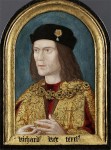 Historians and genealogists have been much excited in the last couple of weeks by the confirmation that the skeleton found underneath a car park in Leicester is that of King Richard III. But who was Richard III, why was he under a car park and what can this find tell us about this much maligned king?
Historians and genealogists have been much excited in the last couple of weeks by the confirmation that the skeleton found underneath a car park in Leicester is that of King Richard III. But who was Richard III, why was he under a car park and what can this find tell us about this much maligned king?
Firstly – the facts. He was born on 2nd October 1452 at Fotheringay Castle in Northamptonshire, the son of Richard Plantagenet, Duke of York, and Cecily Neville. Richard Plantagenet was the great-grandson of Edward III through Edward’s fifth son Edmund of Langley, Duke of York. Cecily Neville’s maternal grandfather was John of Gaunt, Duke of Lancaster, who was the third surviving son of Edward III.
Richard, therefore, had a good claim to the English throne. But at the time of his birth the Wars of the Roses were raging over the throne between the Lancastrian line (symbolised by the red rose) and the Yorkist line (symbolised by the white rose). The Lancastrians were descended from John of Gaunt, and therefore believed they had a stronger right. However, through marriage the Yorkist line could also claim descent from Edward III’s second surviving son, Lionel, Duke of Clarence, and so believed that their claim was stronger.
The Lancastrian Henry VI was a peace-loving king who suffered periods of mental breakdown. This left his throne vulnerable to attack from the Yorkist line, and eventually the Lancastrians were defeated, and Richard’s older brother became Edward IV.
Edward had two sons, Edward and Richard by his wife, Elizabeth Woodville. Edward had married Elizabeth in secret, as she was an unpopular choice amongst his family and friends, and some believed the marriage to have not been valid. On Edward’s death, his first son became Edward V.
This is where the character of Richard III begins to get a bit shadowy. Upon his brother’s death, Richard seized the throne for himself, claiming that Edward’s sons were illegitimate and therefore not in line. The young Edward and his brother were sent ‘for their protection’ to the Tower of London, and then they mysteriously disappeared, presumably murdered.
Richard III has always been the main suspect for their murders, but there has never been any strong evidence other than it was convenient to him for them to be out of the way.
But now a new threat to Richard came from Henry, the son of Edmund Tudor who was also able to claim descent from John of Gaunt from both of his parents. Henry famously defeated Richard at the Battle of Bosworth, and thus founded the Tudor dynasty, becoming Henry VII, the father of Henry VIII. In order to unite the two warring houses, he married Elizabeth of York, the daughter of Edward IV.
We know that Richard III was killed during the Battle of Bosworth, probably from a blow to the head. But how did he end up in a car park? After his death he was buried in a hastily dug grave underneath Greyfriars Church in Leicester without any coffin or shroud. During Henry VIII’s dissolution of the monasteries, Greyfriars Church was demolished and as the area developed its location was forgotten and built over.
The big question for all historians, and one which may never be fully answered, is whether or not he was the villain he has been made out to be. Much of our image of Richard comes from one of Shakespeare’s best plays, Richard III. However, we have to remember that Shakespeare was writing under a Tudor monarch, and writing anything that would undermine the validity of the dynasty would have been an extremely dangerous act indeed. It is also very likely that, just over a century after his death, the common consensus would have very much been very much against him. It is sometimes only centuries after an event that we can become objective.
The question of who killed the princes in the tower is possibly one of the greatest murder mysteries of all time. The blame certainly pointed towards Richard, being their uncle and ‘protector’, and one who had a vested interest in them not existing. But, on the other hand, was Richard the victim of a very clever set-up – one that would not easily be disproved?
What is certain is that Richard’s recent re-appearance after over 500 years is going to open up the debate for new historical research and re-assessment of his character. Perhaps it’s time for us to ask again, who was Richard III really?

